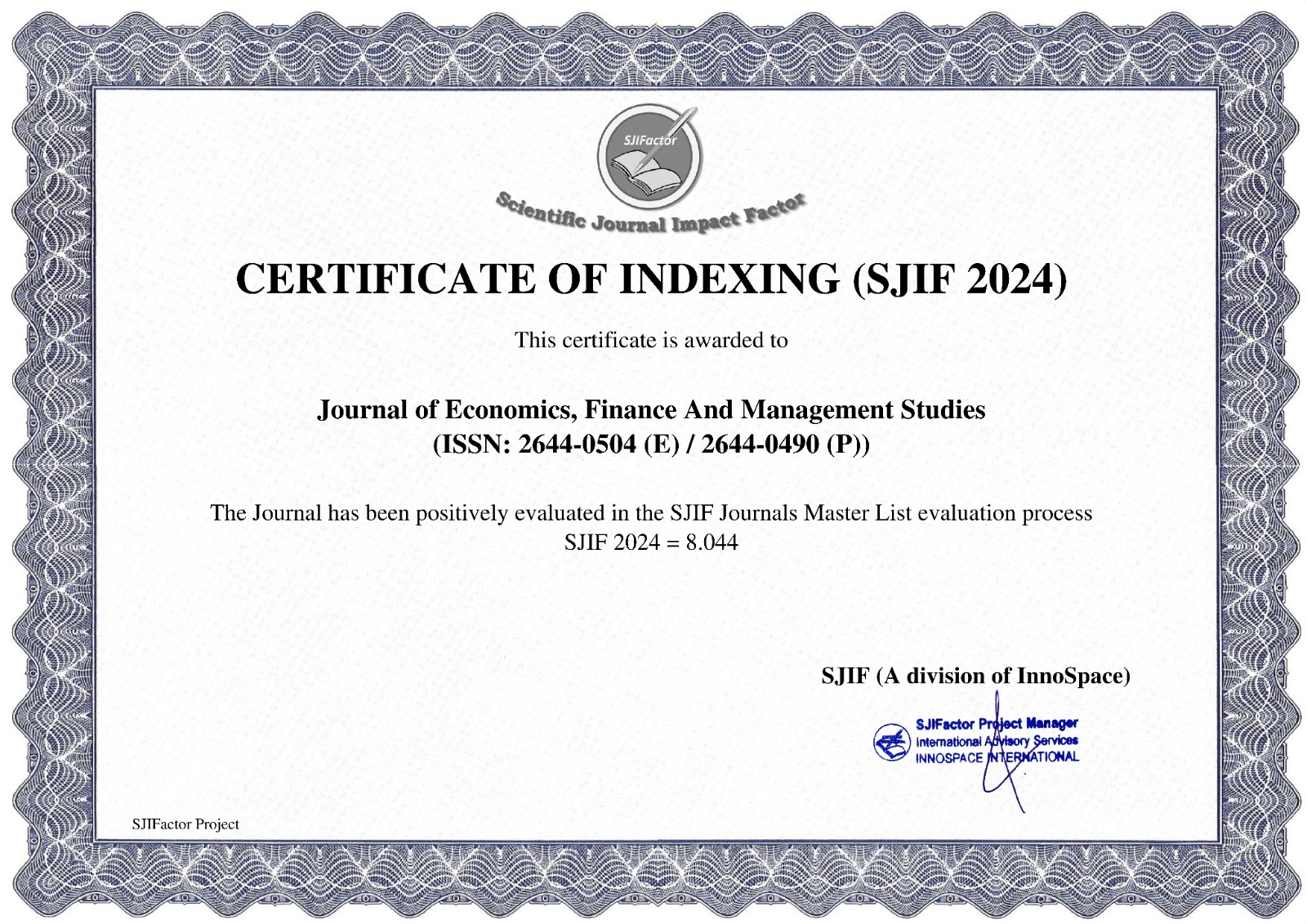An Empirical Analysis of Value and Growth Stocks Performance in Bursa Malaysia
Hani Nuri Rohuma (Ph.D.)
Asst. Professor. Faculty of Economics, University of Benghazi, Benghazi, Libya
https://doi.org/10.47191/jefms/v8-i3-39ABSTRACT:
This study compares the performance of value and growth portfolios in Bursa Malaysia from January 2011 to January 2021 using the book-to-price (B-P) and the earning-to-price (E-P) as valuation proxies. It also compares the performance within small and large market capitalisations. The results affirmed that the growth portfolios beat the value portfolios regarding return across the entire sample. When market capitalisation is considered, the results confirm that the growth effect is still present in the small-cap portfolios. However, the growth effect of large-cap portfolios varies depending on how they are constructed. The value effect is presented in portfolios created by applying the E-P; however, when the portfolio is constructed using the B-P, the value impact is replaced by the growth effect. Furthermore, except for the high E-P portfolio, the size effect is presented in all portfolios from the same category in Bursa Malaysia. As a result, whether the market is subject to the value or growth effect, the results will vary based on the ratios utilised when constructing the portfolio. Furthermore, the results indicate that the best diversification method for an investor in Bursa Malaysia is to establish a portfolio that contains both value and growth portfolios in various market capitalisations. The results of this research might be attributed to the research period, as Bursa Malaysia was affected by the market recovery from the 2007/2008 financial crisis and economic shocks during the beginning periods of the COVID-19 epidemic. Also, some Asian markets suffered disruptions in 2015 and 2016 as a result of the Chinese market's volatility.
KEYWORDS:
Growth Portfolio, Value Portfolio, Bursa Malaysia, Portfolio, Size Effect.
REFERENCES:
1) Abate, G., Basile, I., & Ferrari, P. (2024). The integration of environmental, social and governance criteria in portfolio optimization: An empirical analysis. Corporate Social Responsibility and Environmental Management, 31(3), 2054-2065.
2) AlAli, M.S., AlQamlas, T.N., AlHajri, S.R., AlBasri, N.S., & AlSalem, A.S. (2024). Profitability, Dividend Policy and Stock Prices: A Case Study on Kuwaiti Insurance Companies. International Journal of Finance & Banking Studies, 13(1).
3) Banz, R.W. (1981), The relationship between return and market value of common stocks. Journal of Financial Economics, 9(1), 3-18.
4) Basu, S. (1977). The investment performance of common stocks in relation to their price to earnings ratio: a test of the Efficient Markets Hypothesis. Journal of Finance, 32(3), 663–682.
5) Bauman, W.S., Conover, C.M., & Miller, R.E. (1998). Growth versus value and large-cap versus small-cap stocks in international markets. Financial Analysts Journal, 54(2), 75-89.
6) Bektic, D., Wenzler, J.S., Wegener, M., Schiereck, D., & Spielmann, T. (2019). Extending Fama–French factors to corporate bond markets. Journal of Portfolio Management, 45(3), 141–158.
7) Bevanda, L.M., Zaimović, A., & Arnaut–Berilo, A. (2021). Performance of value and growth stocks in the aftermath of the global financial crisis. Business Systems Research: International journal of the Society for Advancing Innovation and Research in Economy, 12(2), 268-283.
8) Bischof, B. (2021), Value vs Growth: A Brief Historical View. New York: Nasdaq, Inc. Available from: https://www.nasdaq.com/articles/value-vs-growth%3A-a-brief-historical-view-2021-05-06 [Last accessed on 17 Feb. 2025].
9) Chan, L.K., Lakonishok, J. (2004), Value and growth investing: Review and update. Financial Analysts Journal, 60(1), 71-86.
10) Chang, H.W., Chiang, Y.C., Ke, M.C., Wang, M.H., & Nguyen, T.T. (2023), Market efficiency of Asian stock markets during the financial crisis and non-financial crisis periods. International Review of Economics and Finance, 83, 312-329.
11) DeFusco, R., McLeavey, D., Pinto, J., Anson, M., & Runkle, D. (2015), Quantitative Investment Analysis. New Jersey: John Wiley and Sons
12) Fama, E.F., & French, K.R. (1992). The cross-section of expected stock returns. Journal of Finance, 47(2), 427–465.
13) Fama, E.F. (1970). Efficient capital markets: a review of theory and empirical work. Journal of Finance, 25(2), 383–417.
14) Gagliolo, F., & Cardullo, G. (2020). Value stocks and growth stocks: A study of the Italian market. International Journal of Economics and Financial Issues, 10(3), 7-15.
15) Geczy, C.C., & Guerard Jr. (2024). Price Momentum, Earnings Forecasting, and Valuation: Implications for Inefficient Markets. In Handbook of Investment Analysis, Portfolio Management, and Financial Derivatives, 4, 3369-3386.
16) Glasgow, K. (2022). Effectiveness of Value Investing in the European Energy Sector. Master’s Thesis. Finland: Hanken School of Economics.
17) Graham, B., & Dodd, D.L. (1934). Security Analysis, McGraw-Hill, New York, United States.
18) Guerard, J., & Mark, A. (2021). Earnings forecasts and revisions, price momentum, and fundamental data: Further explorations of financial anomalies. In Handbook of financial econometrics, mathematics, statistics, and machine learning (pp. 1151-1209).
19) Gulen, H., Xing, Y., & Zhang, L. (2011). Value versus growth: Time‐varying expected stock returns. Financial management, 40(2), 381-407.
20) Hsieh, H.H. 2015. Empirical investigation of the value effect in the large and small cap segments of the JSE: evidence from the South African stock market. Investment management and financial innovations, 12(4), 16-22.
21) Jackson, A-L. (2025). Growth vs. Value Stock Investing: Understanding the Differences. NerdWallet. Available at: https://www.nerdwallet.com/article/investing/value-vs-growth-investing-styles [Last accessed on 1 Mar. 2025].
22) Koner, K. (2024). Value Vs Growth Stocks: A Literature Survey. International Journal of Current Science Research and Review, 07(11), 8436-9441
23) Lakonishok, J., Shleifer, A., & Vishny, R.W. (1994). Contrarian Investment, Extrapolation, and Risk, Journal of Finance, 49 (5), 1541-1578.
24) Neves, M.E., Pinto, M.A., de Assunção Fernandes, C.M., & Vieira, E.F.S. (2021). Value and growth stock returns: international evidence (JES). International Journal of Accounting & Information Management, 29(5), 698-733.
25) Penman, S H., & Reggiani, F. (2018). Fundamentals of Value vs. Growth Investing and an Explanation for the Value Trap. Financial Analysts Journal. (74)4, 103–119.
26) Rohuma, H. (2023). Value Stocks versus Growth Stocks: An Examination of Bursa Malaysia. International Journal of Economics and Financial Issues, 13(4), 143-151.
27) Rohuma, H.N., & Alzwi, A.S. (2025). Does the Carhart (1997) Four-Factor Model Still Applicable? Evidence from Stocks Listed on Bursa Malaysia. International Journal of Economics and Financial Issues, 15(2), 367-374.
28) Van Rensburg, P., & Robertson, M. (2003). Style characteristics and the cross-section of JSE returns. Investment Analysts Journal, 32(57), 7-15.
29) Vasconcelos, L.N.C.D., & Martins, O.S. (2019). Value and growth stocks and shareholder value creation in Brazil. Revista de Gestão, 26(3), 293-312.
30) Yeh, I.C. (2024). Comparisons of residual income model and growth value model. Applied Economics, 56(11), 1327-1345.
31) Yen, J.Y., Sun, Q0, & Yan, Y. (2004). Value versus growth stocks in Singapore. Journal of Multinational Financial Management, 14(1), 19-34.
















